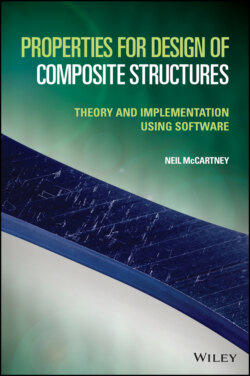Читать книгу Properties for Design of Composite Structures - Neil McCartney - Страница 45
3.1 Introduction
ОглавлениеEstimating the effective thermoelastic and conduction properties of particulate composites is a very important engineering requirement that has been studied for many years. Examples of particulate-reinforced materials are concrete and the more recent developments in the metal matrix composites sector. A characteristic of both these materials is the irregular nature of particle geometry and their size. When modelling such materials, especially for analytical approaches, the particle geometries are usually idealised to spheres, spheroids (a good approximation to whiskers) or ellipsoids (useful when particles are in a platelet form). The immediate technical objective is to develop methods of estimating the effective thermoelastic properties of such materials. There are various methods of estimating the effective properties of particulate composites using analytical methods (see, for example, [1, 2]), but the approach that is considered here is that due to Maxwell [3], who is believed to have derived the first ever formula for an isotropic effective property (electrical conductivity) of a composite material (an isotropic medium reinforced with isotropic spherical particles).
Maxwell [3] provided an ingenious method of estimating the effective electrical conductivity of a cluster of spherical particles having spherical shape embedded in an infinite medium by considering the effect of the cluster on the far-field when the system is subject to a uniform electrical field. Maxwell asserted that the sizes and distribution of the particles must be such that particle interaction effects may be neglected, and he infers that his result will be valid only for small volume fractions of reinforcing particles. A detailed study [4] of the method used by Maxwell demonstrates that his methodology, focusing only on the far-field, can also be applied to the estimation of other properties of composite materials. As will become clear in this book (see Chapters 4 and 15), his methodology can easily be applied to composite materials reinforced with parallel fibres or aligned spheroids, the latter being used when considering short fibre or whisker reinforcements.
The principal objective of this chapter is to show, based on the approach described in [3], how Maxwell’s methodology, first developed to estimate electrical conductivity, can also estimate the effective bulk modulus, shear modulus and thermal expansion coefficient of multiphase isotropic composites reinforced with homogeneous spherical particles. The methodology of Maxwell is naturally extended so that assemblies of multiphase spherical particles having a range of radii and/or properties may be considered. A second objective is to show that Maxwell’s methodology is one reliable technique that provides closed-form estimates of effective properties and is not necessarily restricted to low volume fractions of particulate reinforcement. The first step is to describe the method developed by Maxwell [3] to estimate the effective isotropic conductivity of a composite reinforced with a uniform distribution of spherical particles. The analysis is presented in a thermal rather than electrical context, as it is a scenario more relevant to the other chapters in this book, and the thermal approach is, in fact, an exact analogue of the electrical counterpart.
